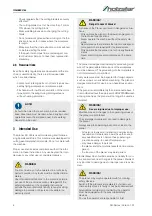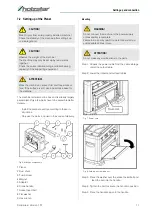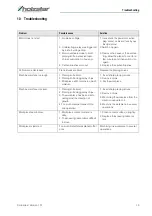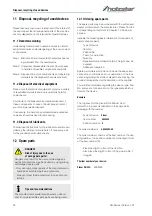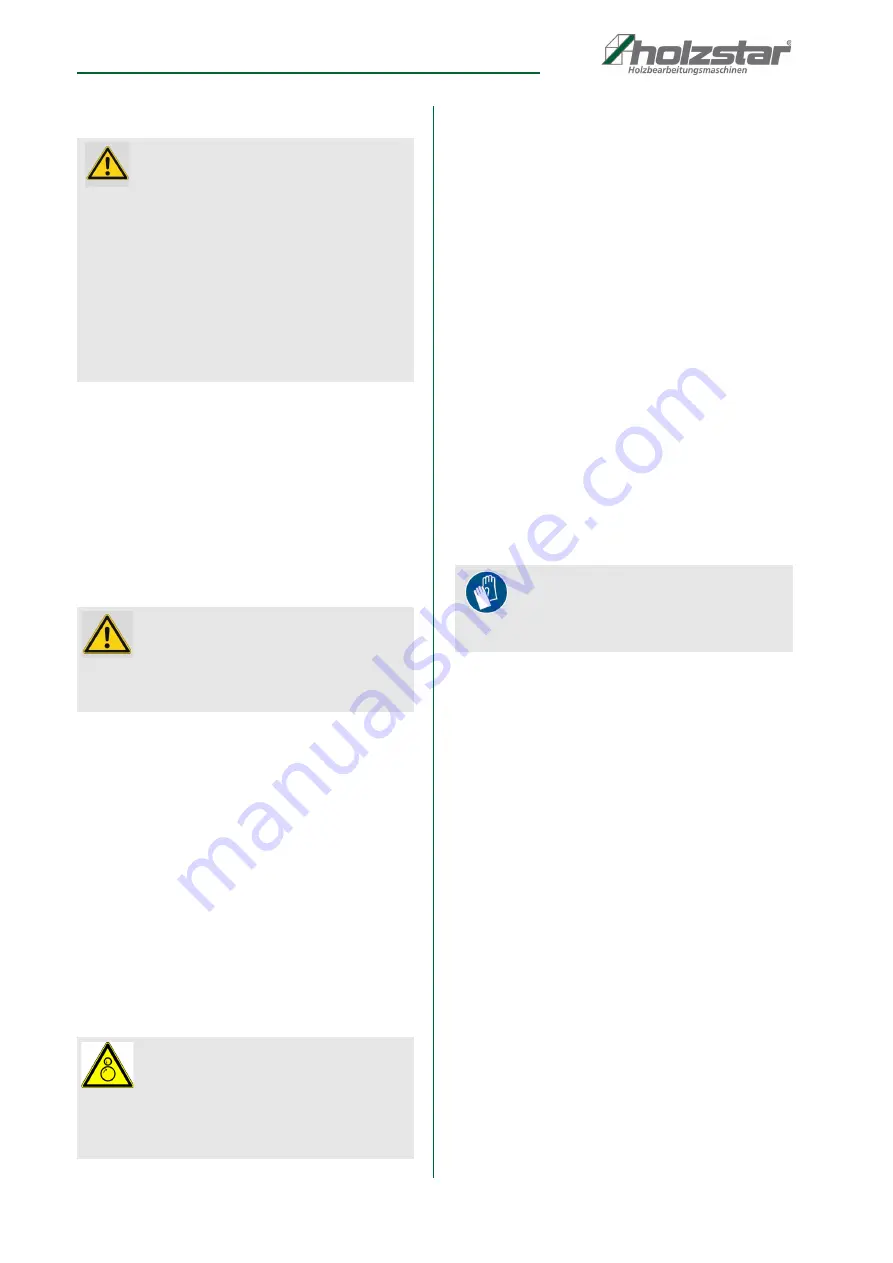
6
DH-Series | Version 1.01
Safety
2.6 For your own safety
The European standards must be observed when instal-
ling, operating, maintaining and repairing the planer.
For the European standards not yet transposed into the
respective national law, the still valid country-specific
regulations must be applied.
Operators of the planer outside the scope of the Euro-
pean Standards are obliged to comply with the safety
and accident prevention regulations applicable in the
country of operation. If necessary, appropriate measu-
res must be taken to comply with the country-specific
regulations before the planer is put into operation.
Safety during operation
Before using the planer, make sure that
- There is no danger to persons.
- No things are damaged.
- Do not work in any way that is dangerous to safety.
- Use personal protective equipment such as a dust
mask, hearing protection and protective goggles.
- Use an extraction system to extract wood and saw-
dust. The extraction speed must be 20 m/s at the
extraction head.
The residual hazards listed below are always the re-
sponsibility of planners and cannot be completely aver-
ted by safety devices.
Danger due to insecure position.
For long workpieces, use suitable workpiece supports
on both sides of the planer. Avoid an unfavorable po-
sture. Make sure that you stand securely. Keep the wor-
king area clean..
Danger to other persons in the working area
Keep the unauthorised persons, especially children,
away from the danger area. Point out the hazards of the
planer to persons who will help you when working on the
planer.
Danger from touching the rotating cutter head
Always keep sufficient distance to the cutter head.
Switch off the thickness planer when it is not in use.
Risk of the workpiece hitting back
The workpiece is picked up by the cutter head and
thrown against the operator. Work only with the non-re-
turn device functioning correctly. Only use sharp pla-
ning knives. Check the workpiece for foreign objects be-
fore starting work.
Consider work area’s environment
.
Do not use the planer in the rain or in a humid environ-
ment. Ensure that the workplace is adequately lit. Do not
operate planer near flammable gases or liquids. Keep
uninvolved persons, especially children, away from the
danger area. Point out the dangers to the machine to
persons who help you with work on the planer.
Risk due to defects on the planner.
Before each use, check the planer for damage or dis-
mantled, defective protective covers and protective de-
vices. Do not use the planer if a part is defective. Re-
place blunt planing knives immediately. There is a risk of
kickback if a blunt planer knife gets caught in the sur-
face of the workpiece.
Danger of overloading the planer
Only operate the planer in the specified power range.
Use the planer only for the purpose for which it is inten-
ded.
Before each switch-on, make sure that there are no objects such
as tools in the planer.
WARNING!
The planer is a dangerous machine that can cause
serious injury if left unattended. It is therefore essen-
tial that you follow the following safety instructions:
- The planer may only be put into operation and ope-
rated by persons who are familiar with the planer-
thicknesser and are aware of the dangers involved
in working with the planer.
- Persons under the age of 18 may only use the pla-
ner within the framework of vocational training and
under the supervision of an instructor. In this case,
the minimum age is 16 years.
DANGER!
Do not use your fingers to look for end position swit-
ches in order to be able to switch on the planer in a
way other than intended.
ENTANGLEMENT HAZARD!
Ensure that no parts of the body or clothing can be
caught by the machine and pulled in during opera-
tion. Wear tight-fitting clothing and if necessary a
hair net.
Protective gloves
Use protective gloves when changing the planing
knife.








